
Innovating’s Top 10 Governing Conditions
These top 10 conditions are always true in practice.
1. There is an existing solution for everything a person wants to do or accomplish. There are always existing solutions and competitors in every market space.
2. You have to definitively position your new solution relative to the existing solution (quality of user experience versus price) for the targeted customer type to compete effectively.
3. You will gain more traction sooner by targeting over-served, under-served, or non-served customers first. Nominally served customers have the least incentive to change solutions.
4. 80% of all innovations have their genesis in dissatisfaction with the user experience with their chosen solution.
5. You have to identify problems worth solving. A problem worth solving is a source of trouble for both the customer and the supplier.
6. There must be enough novelty associated with a new solution to capture customer awareness and make it attractive enough to consider as a replacement for the current solution. But novelty is transient. It drives temporary substitution, not adoption.
7. People will adopt a new solution if and only if there is a NET IMPROVEMENT IN USER EXPERIENCE AND a NET REDUCTION IN TROUBLE compared with the existing solution.
8. In an established business, the bias to the status quo with the existing solution is strong. Leadership must actively seek to increase the dissatisfaction with the existing solution while simultaneously working to increase the desire for the new solution to overcome the bias.
9. You have to overcome the bias to the status quo and achieve acceptance within the business before you have a chance to achieve adoption in the marketplace.
10. Adoption is the final test of whether a new solution is an innovation.
🌱
To be or to do?
Complex or complicated?
Clarity is key
– haiku, Kevin A Fee, Nov 20, 2023
